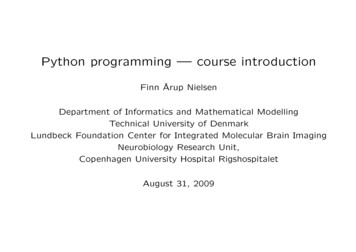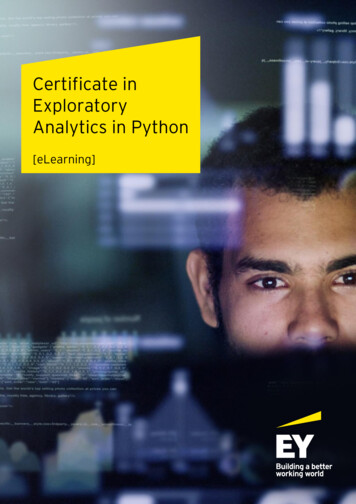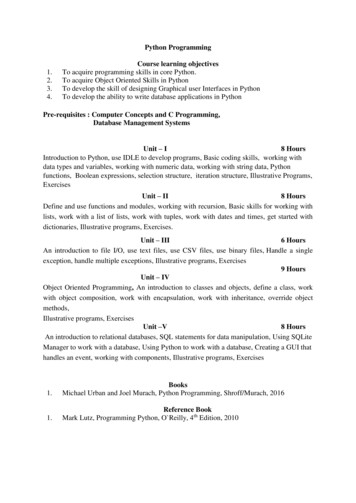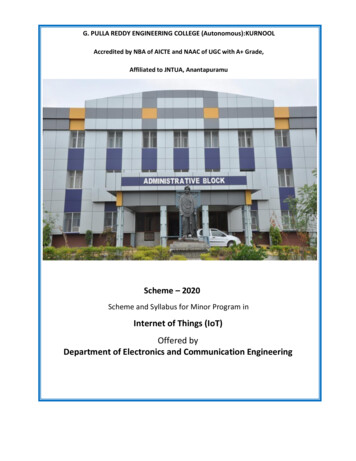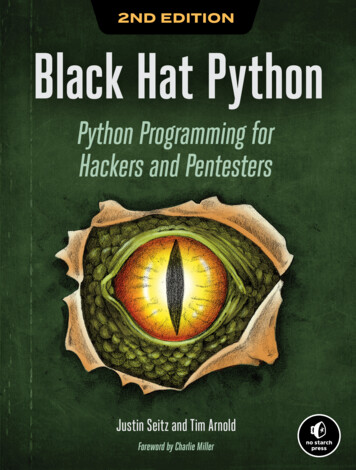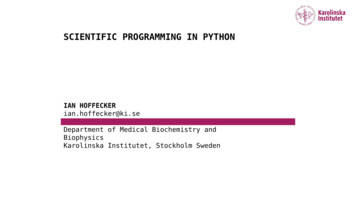
Transcription
SCIENTIFIC PROGRAMMING IN PYTHONIAN HOFFECKERian.hoffecker@ki.seDepartment of Medical Biochemistry andBiophysicsKarolinska Institutet, Stockholm Sweden
Outline Motivation scientific programming Python vs other languages The anatomy of a program fundamentals flow diagrams Basic concepts - demo variables lists conditional statements loops files, input and output, Solving scientific problems with programming analyzing and visualizing data Tips to get started on your own editors and consoles anaconda - scientific programming packages learning resources finding your first “personal” project
Get InspiredA new, a vast, and a powerful languageis developed for the future use ofanalysis, in which to wield its truthsso that these may become of more speedyand accurate practical application forthe purposes of mankind than the meanshitherto in our possession have renderedpossible.- Ada LovelaceProgramming is a skill bestacquired by practice andexample rather than from books.- Alan Turing
Inspirational reading about the history of computing The Innovators Walter Isaacson about thehistory ofcomputing,programming,transistors, theinternet. Turing's Cathedral - GeorgeDyson about the first storedmemory digital electroniccomputers and the role ofJohn Von Neumann The Information James Gleick about thehistory ofinformationtheory
Expectations and Plan for the CourseSome of you. are already confident, competent scientific programmers have some experience programming but are not confident about it know a programming language, but it is not the one we are doing have zero experience programming We will.introduce/remind you of basics concepts in programming todaygive you some exposure to scientific programminguse this basis for learning bioinformatics throughout the rest of thecourse If you are new to programmingspend extra time on the basicsask us and your peers for helpresearch it independently If you are already advanced use the tools we give you to experiment on your own help your peers
Uses for programming (specifically Python examples) Scripting / file management programs that manage files, copying, creating folders,importing data from text files, sorting images. Eliminate or reduce the cost of repetitive tasks
Uses for programming (specifically Python examples) Make use of other people's code A seating preference optimizer No executable download or web-based solution Someone coded this algorithm in Python though We can use it so long as we know how to run it
Uses for programming (specifically Python examples) Manipulating and searching through text algorithm parses text and ranks words according to theirfrequency useful for learning a new language
Uses for programming (specifically Python examples) Applying and inventing creative data visualizations forscience
Uses for programming (specifically Python examples) Controlling hardware an LED that flashes with a desired frequency tostimulate light-sensitive proteins
Uses for programming (specifically Python examples) Simulating things especially when we don't know the math many scientific questions are easier to simulate thanderive an analytical expression for e.g. for a given density of randomly placed red dots andblack dots, what is the fraction of pairs that landwithin distance x of each other?
Uses for programming (specifically Python examples) Simulating things especially when we don't know the math many scientific questions are easier to simulate than derive ananalytical expression for e.g. for a given density of randomly placed red dots and blackdots, what is the fraction of pairs that land within distance xof each other?Mathematician's approach:Programmer's approach:derive what's known as theGenerate two sets of coordinatesnearest neighbor distributionand compute the distancesusing calculus and probabilitybetween themtheory
Uses for programming (specifically Python examples) Process images! reconstructing super resolution microscopy data analyzing the images to detect certain featuresautomatically remove human bias by having the machine do it
Uses for programming (specifically Python examples) Machine learning/classification pick out structures in images and group structures into 2D classes
Uses for programming (specifically Python examples) Do symbolic math/algebra/calculussolving expressions like you would on papersimilar to Wolfram Alpha or Mathematicafree and integrated with the rest of Python
Python compared to other languages Python is an Interpreted language Commands are executed by an interpreter Interpreter has subroutines already for translating new code intomachine language Means that time is spent on translation during the running Python is thus slower as a result! Syntax is easier to learn, code is more readable Compiled languages (e.g. C , C, Java) A step is taken before running a new program to convert the code intomachine code Ultimately leads to faster performance Syntax is “closer to the machine” and thus more complex! Useful for big software projects and under-the-hood applications Most python libraries like numpy are written in precompiled code likeC Python is a general language Some languages are optimized for certain tasks and can be worth using incertain contexts e.g. R, matlab, mathematica. general languages have the advantage of being able to bring differentspecialties together
Industry usage Google “Python where we can, C where we must” an official server-side language along with C , Java, and Go Google’s very first web-crawling spider was first written in Java 1.0 and was sodifficult that they rewrote it into Python. -Steven Levy “In the Plex” Spotify uses a combination of Python and C for backend framework uses Python for analytics - a module called Luigi preferred because of the fast development pipeline Reddit site was originally coded in Lisp - recoded into Python in 2005 shortly afterlaunch “There’s a library for everything. We’ve been learning a lot of thesetechnologies and a lot of these architectures as we go. And, so, when I don’tunderstand connection pools, I can just find a library until I understand itbetter myself and write our own. Don’t understand web frameworks, so we’ll usesomeone else’s until we make our own Python has an awesome crutch like that.” Steve Huffman Others big companies using Python Facebook, Quora, Dropbox, Netflix, Isntagram.source: -python/#spotify
Prevalence in science Fast prototyping pipeline is ideal forscience less focus on end-product software forusers more focus on getting an answer,visualizing data, inventing newalgorithms Large and growing free opensourcecommunity more libraries due to large user base more resources to get help crowd-sourced maintenance rather thancentralized maintenance by commercialdevelopers (e.g. Matlab or MS ExcelVBA)
The Case for Learning Programming as Scientists/Engineers Freedom to build any tool that you need Professional caliber capability for free Socially active community of users and developers Easy to learn other languages once you know one A medium for learning (especially new math concepts) Understanding and reproducing other scientists' work Participate in our era - computing/information are the defininigfeatures of today
The anatomy of a program An input or initial state A series of steps steps are carried outin order one after theother each step modifies thestate An output or final stateStartStep 1Step 2Step 3End
Majority of real programs have decisions and loopsStartwrite a programthat computes thesolution to a basenumber (2) raisedto a power (8)my base 2my exponent 8solve 1counter 0counter my exponentFALSEprint solveEndTRUEsolve solve *my basecounter counter 1vel68so 211634582642 n tou c re 38742651
Python variables get defined when you assign them a value
Variables can be defined using different data types integers, floats, strings
Two kinds of equal signs: definition and evaluation
Conditional Statements (Decisions) and indentation syntax
Python modules, packages, and libraries
Python modules, packages, and libraries
Python modules, packages, and libraries
Python modules, packages, and librariescool or useful libraries to know about: numpy essential for all numerical problems, plotting, data management scipy lots of statistics, machine learning, and useful mathematical functions implement them first, understand them second - great way to learn newmath networkx library for generating and visualizing networks/graphs biopython library for dealing with biological sequence data matplotlib essential for dealing with images, plotting, making figures forpublications, animations. random functions for generating random numbers - very handy for simulation os short for “operating system” - very handy for manipulating files loading them, writing them, copying and pasting etc
Lists
Numpy - a library for arrays and matrices numpy for numerical/mathematical operations, linearalgebra, matrix operations lists for organization, looping a lot of overlap and conversion between them
Multidimensional arrays and lists
for Loops
while Loops
Implementing our exponentiator
Scientific programming - data and plotting
Scientific programming - data and plotting
Scientific programming - data and plotting
Scientific programming - data and plotting
Knowing where to start - tips for visualizing programs arrays and lists are like columns and rows in spreadsheets for loops are like the “drag” function in spreadsheets
Knowing where to start - tips for visualizing programs arrays and lists are like columns and rows in spreadsheets for loops are like the “drag” function in spreadsheets
Knowing where to start - tips for visualizing programs arrays and lists are like columns and rows in spreadsheets for loops are like the “drag” function in spreadsheets
Debugging by exploring from “within” a program use a set trace() command to explore a program at a specific line!
The important art of Googling
Use text returned from errors to identify location and type of error
Googling gets easier as you learn vocabulary
Borrow sample code and modify it
Tips for getting started on your own download and install a distribution ofPython anaconda is a good one (free, comes withmany scientific programming libraries) download and install a program editor (forwriting and saving code) Spyder - a good, free editingapplication that we will use in ourexercises
Tip: come up with your own project - something you care about take a spreadsheet and convert it into Python pick something from a math or science textbook andimplement it in Python networks machine learning bioinformatics :) pick a boring/repetitive task that you have to do oftenand automate it make something visual with matplotlib data visualization animation plot a nice mathematical function
Independent learning resources youtube thousands of tutorials on everything from basicsto specific libraries MOOCs - massive online open course Coursera EDX forums - ask questions and get answers from otherprogrammers stack overflow reddit
know a programming language, but it is not the one we are doing have some experience programming but are not confident about it We will. introduce/remind you of basics concepts in programming today give you some exposure to scientific programming use this basis for learning bioinformatics throughout the rest of the course


